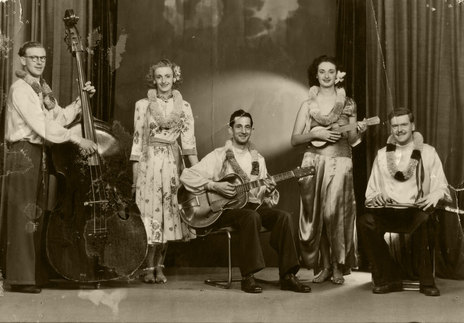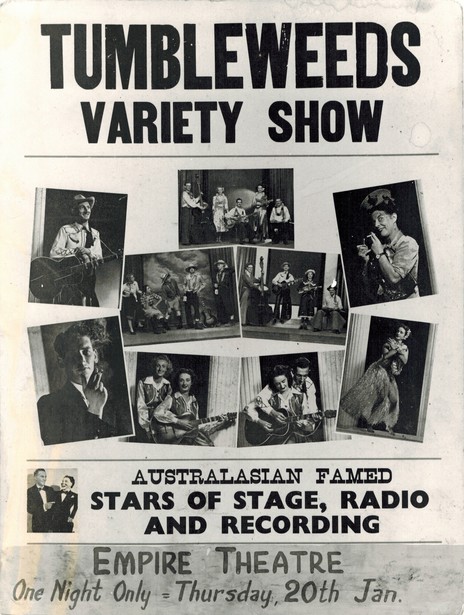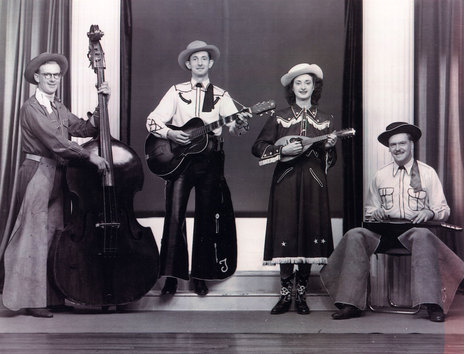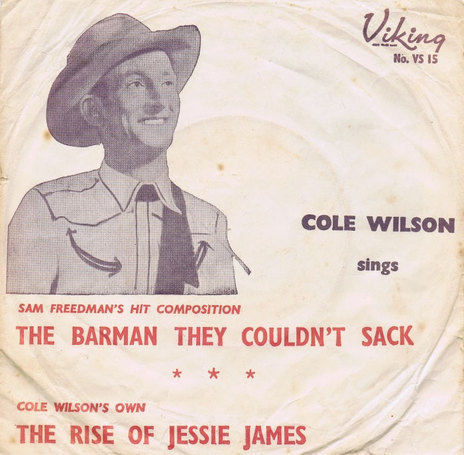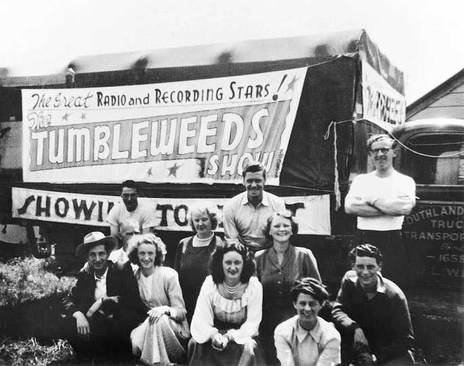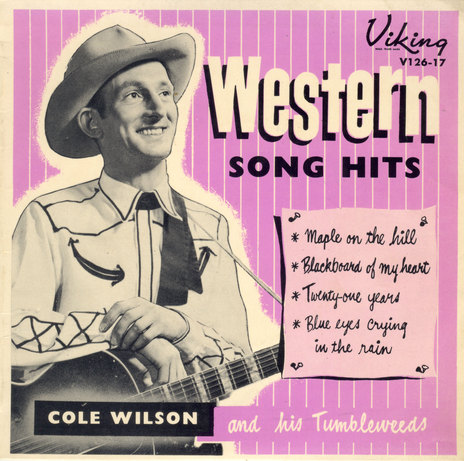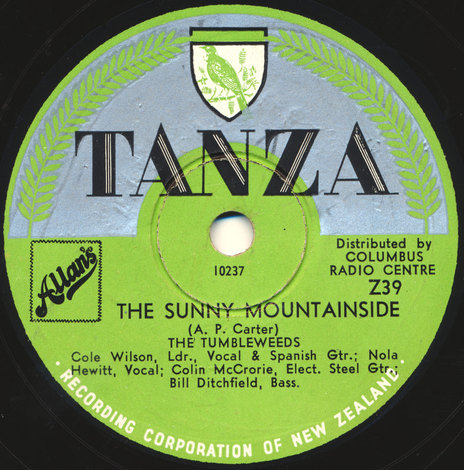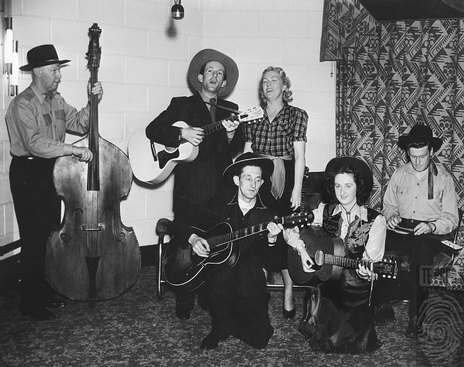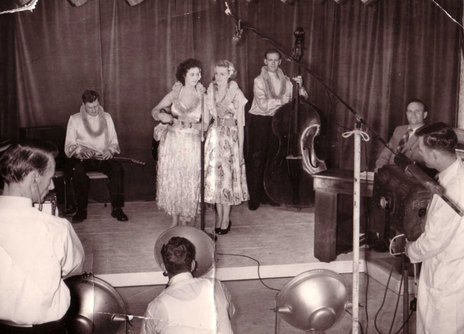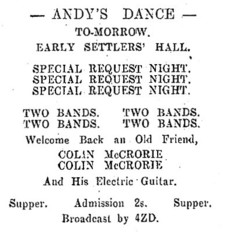The group needed persuading by its lead singer, Cole Wilson, to record the song. His backing vocalists, sisters Myra and Nola Hewitt, thought it was a monotonous dirge. “However he was adamant,” Nola told Chris Bourke in 2006, “and we did it.” After the song became so popular, Wilson joked that he would ignore the sisters’ comments from then on. The song is the story about a man who wants to be remembered after his death, and is deeply melancholic. When Tanza released ‘Maple On The Hill’ b/w ‘Will You Be Lonesome Too?’ in 1950, it was an immediate hit.
When Tanza released ‘Maple on the Hill’ b/w ‘Will You Be Lonesome Too?’ in 1950, it was an immediate hit.
A crucial part of the Tumbleweeds’ image and music was that it was a family band: two husbands and their wives, who happened to be sisters. Nola and Myra Hewitt grew up in Dunedin in the 1930s, in a family that often sang together. Their father was a steel guitarist, and their mother played banjo-mandolin. The sisters harmonised to Hawaiian, country and Māori songs, Nola learnt the mandolin, guitar and ukulele, and Myra the steel guitar. They enjoyed country music sessions on the radio, and were members of the Begg’s Musical Army, a large group of young music pupils organised by the Dunedin-based instrument retailer.
It was through the Begg’s Musical Army that they met guitarist Cole Wilson, who had learnt to play from Carter Family and Jimmie Rodgers records. He joined in the sing-a-longs at the Hewitt household. Meanwhile, another member of the Begg’s Musical Army, Bill Ditchfield, was a double-bass player and had formed the Hawaiian Serenaders with lap-steel guitarist Colin McCrorie. He saw the Hewitt sisters performing a hula dance at a concert, and asked them to become part of the Hawaiian Serenaders’ floor show. After hearing them sing ‘Maple on the Hill’ on radio station 4YA, Ditchfield had the idea of forming a country band, and approached Nola Hewitt.
The original quartet got together in March 1949: Nola Hewitt, Ditchfield, McCrorie and Wilson. Just six months later – thanks to their broadcasts on 4YA – Tanza Records asked them to come to Wellington to record. The group travelled by train and ferry, and the sessions took place over a weekend, with Tanza pioneer Stan Dallas engineering. ‘Maple on the Hill’ was one of the songs completed.
Shortly after The Tumbleweeds returned to Dunedin, they met Tex Morton, who was touring New Zealand. “We were on 4ZB that night,” recalled McCrorie in 2006, “and they arranged for him to be a guest of ours. Halfway through the programme he hadn’t arrived. That studio in ZB was a terribly dead thing, and Bill had his big bull fiddle up on a table top for a bit of resonance. After we’d finished one number, the door burst open and Tex walks in. But on the way to the microphone his elbow caught the music stand, and it clattered down. He just carried straight on, and said ‘Oh! There must be a mouse in the studio!’ He was a great showman.”
In 1950 The Tumbleweeds returned to Wellington for another weekend at Tanza, recording a dozen songs. At a party afterwards, Dallas heard McCrorie playing some of his Hawaiian Serenaders’ numbers, and decided to record them in the morning before The Tumbleweeds caught their ferry home. Eight sides were released from this session, all in the Hawaiian style; essentially the Tumbleweeds in grass skirts rather than chaps, this group was called Colin McCrorie and the Kalua Islanders.
The debut tour, in late 1951, introduced many New Zealanders to their first country band.
While enjoying a long career – The Tumbleweeds were still performing in the 1980s – the group only made two substantial tours outside Otago. The debut tour, in late 1951, introduced many New Zealanders in the provinces to their first country band (as opposed to solo artists, such as Morton). The troupe featured eight performers, travelling by – and sleeping in – a truck and caravan. Between them they could offer a complete variety show, with country, Hawaiian, hillbilly, and Latin-American music, as well as comedy, magic and hula dancing.
Myra Hewitt, who joined in 1951, created their outfits from watching Gene Autry and Roy Rogers films, making fringed cowboy shirts by shredding silver braid. Because cowboy boots were virtually impossible to buy, Myra had a cobbler build up the heels of gumboots, cut the uppers into shape, braid them with rubber and then paint the boots white. “They looked good on stage, but weren’t for close inspection,” said Nola.
Others in the troupe were the magician Escilante (Ewen Blackley), risqué comedienne and makeup artist Kaye Hewitt (aunt of the Hewitt sisters), and Stewie Whip as a compere/comedian. “It was non-stop,” recalled Nola. “While we were changing, there would be a small skit in front of the curtains: it went on all night.” Understandably, The Tumbleweeds regarded this eight-month tour as the highlight of their lives. In the fifth month, a double wedding took place, when Cole Wilson married Myra Hewitt, and Colin McCrorie married Nola Hewitt.
The group recorded many 78rpm discs for Tanza and, later in the 1950s and 1960s, albums and 45s for the Viking label. The later discs featured country perennials and also many original songs written by Wilson. They were often recorded in the McCrorie’s living room at Signal Hill Road, Dunedin, by Laeo Padman, a local inventor and audio technician. For these releases, Viking renamed the group Cole Wilson and the Tumbleweeds, a point of contention among some of the other members.
--
Read more: Maple on the Hill – The True Story of the Tumbleweeds, by Nola McCrorie
